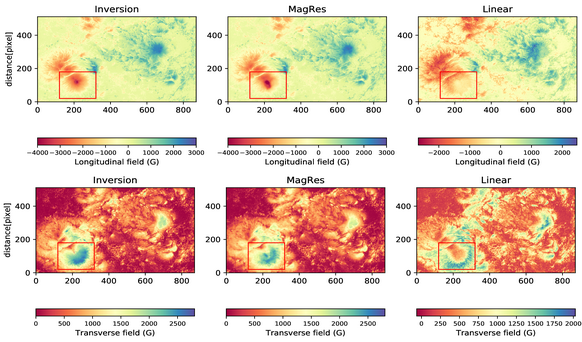Machine learning helps the nonlinear solar magnetic field calibration
Watching the sunrise and sunset gives people an illusion of peace and serenity. It's actually quite lively on the Sun: prominent features such as sunspots, flares, filaments, prominences and coronal transient events pop up from time to time, making the Sun look colorful.
How these flickering activities begin and end has puzzled scientists. Researches show that the mechanisms behind these amazing phenomena are highly related to the evolution of magnetic fields. Then, the accurate magnetic field measurements will help us better understand this celestial body on which we rely.
At present, the solar magnetic field is generally measured indirectly by means of the Zeeman effect (Hale 1908). What we obtain from solar telescopes are the narrow-band linear or circular polarization maps. Then how to convert these maps into the magnetogram is a key question.
For the filter-based magnetograph, the transform process is called magnetic field calibration. The traditional method is the linear calibration which exist the magnetic saturation.
The researchers from National Astronomical Observatories of Chinese Academy of Sciences (NAOC) explore a new method, Machine Learning (ML), to carry out the nonlinear magnetic calibration. The results of ML can effectively overcome the magnetic saturation and infer the strong magnetic regions much better than the linear calibration method.
The authors from NAOC, Yunnan Observatories of China, and Big Bear Solar Observatory (BBSO) of the USA conducted the study that was published in Astronomy & Astrophysics on Feb. 10, 2021.
"The success of this research depends on the powerful nonlinear approximation capability of ML," said Prof. Kaifan Ji, who is the corresponding author of the paper from Yunnan Observatories. "It is a new tool for the astronomical data processing."
The produced magnetogram from ML method are much cleaner than the target maps, indicating the methods has the function of denoising.
"The study is of great value. More accurate magnetogram are expected to provide for the scientific research," said Dr. Xianyong Bai, who is the corresponding author of this study from NAOC.
"This work has a significant contribution to the Full-disk Vector Magnetograph onboard ASO-S, the first solar observation satellite in China. And it also provides useful reference for data processing of the other solar magnetic field telescopes," said Prof. Yuanyong Deng from NAOC.
The paper can be accessed at https://www.aanda.org/articles/aa/abs/2021/02/aa38617-20/aa38617-20.html

Figure: The results of the inversion, MagRes, and linear calibration for the Bl (top) and Bt (bottom). (Image by Guo et al)
Media contact: Prof. XU Ang, annxu@nao.cas.cn